A heart disease dietitian is a trusted nutrition expert, specializing in cardiac nutrition.
From what you hear on the news, or read online, eating right can seem like a big challenge. Diet books and food trends may seem like easy solutions, but the personalized advice of a registered dietitian (RD) is your best choice for credible information, backed by science.
Top Takeaways
- Role of a Dietitian: Heart disease dietitians are experts in cardiac nutrition, offering credible, science-backed nutrition advice.
- Who Needs a Dietitian: Individuals with conditions like high cholesterol, high blood pressure, diabetes, and heart disease can benefit from the guidance of a heart disease dietitian.
- Strategies for Heart Health: Focus on controllable factors like healthy eating, physical activity, stress management, weight control, and avoiding harmful habits to reduce heart disease risk.
- Dietary Recommendations: Incorporate plant foods, healthy fats, and set specific, measurable goals with the help of a dietitian to improve heart health.
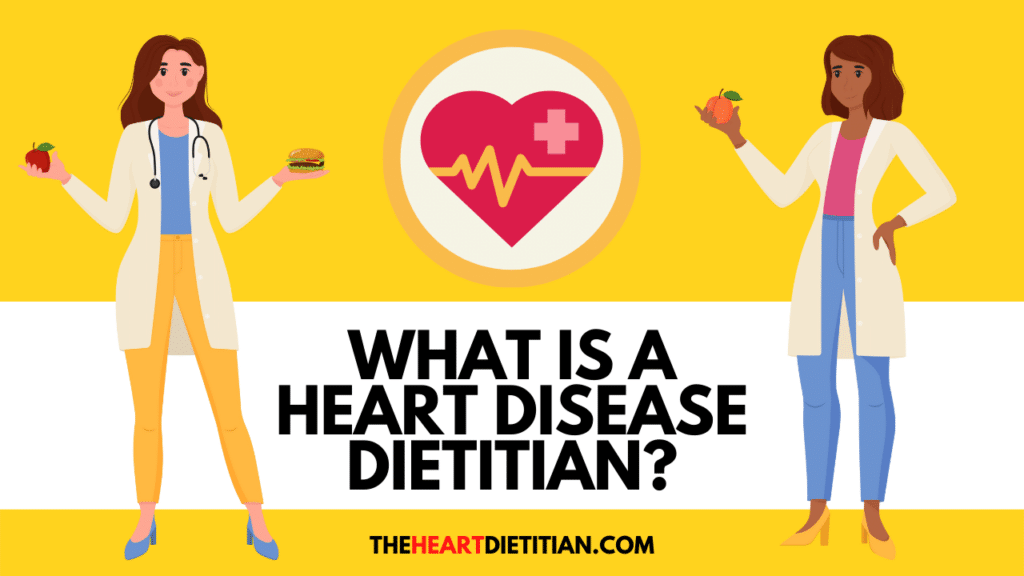
- Top Takeaways
- Pin It For Later
- What is a Dietitian?
- What Is a Heart Disease Dietitian Video
- Who Needs to See a Heart Disease Dietitian?
- How to Reduce Your Risk for Heart Disease
- What to Expect When Meeting with A Cardiology Dietitian
- Strategies to Improve Heart Health
- Top 3 Recommendations
- Activities To Do With Your Dietitian
- Final Thoughts
Pin It For Later
What is a Dietitian?
In coming across the term ‘dietitian’, you may be asking yourself questions like:
- What does a dietitian do?
- How can a dietitian help me?
- What’s the difference between a dietitian and a nutritionist?
To put it simply, the role of a dietitian is to be your trusted source for credible nutrition information. Not only are dietitians able to understand complicated nutrition research, but they are also able to break down this research into useful recommendations for better health (1).
Dietitians aim to work with you and come up with the best possible plan for you to achieve your nutrition- and health-related goals.
Additionally, dietitians work in all types of different places!
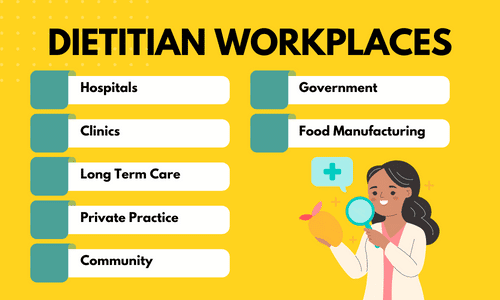
Did you know that the term ‘nutritionist’ is not a regulated term in most Canadian provinces? In fact, outside of Alberta, Quebec, and Nova Scotia, anyone can call themselves a nutritionist (1). The title ‘dietitian’, on the other hand, can only be used by people who have been fully trained.
Dietitians are trained to (2):
- Clarify information
- Provide evidence-based information
- Evaluate your diet
- Suggest changes in your eating
- Empower you to make changes
- Enhance your health
- Help you enjoy food
Dietitian Education
To earn the title of a dietitian, students in a university-level, a dietetic program must complete the following:
- 4-year undergraduate degree in nutrition
- 1-year supervised practicum program
- A national registration exam
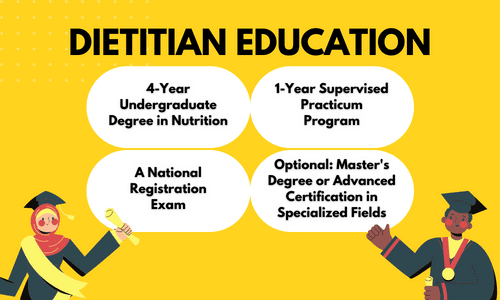
What Is a Heart Disease Dietitian Video
Who Needs to See a Heart Disease Dietitian?
Heart disease is the second most common cause of death among Canadians (3). Canadian Chronic Disease Surveillance System data from 2017-2018 has shown that almost 1 in 12 Canadian adults have been diagnosed with heart disease (3).
Making changes to your diet is a pillar in the management of heart disease. Figuring out what changes to make and how to put them into effect can be overwhelming, to say the least. This is where a heart disease dietitian or a cardiology dietitian can help!
Reasons, why somebody might visit a dietitian for heart disease, include:
- High cholesterol
- High blood pressure
- Congestive heart failure
- Coronary artery disease
- Diabetes
- Chronic kidney disease
- Gastroesophageal reflux disease (GERD)
- Metabolic syndrome
- Weight loss
- [O3]
- General healthy eating or lifestyle changes
- Nutrition optimization prior to surgery
- Nutrition optimization post-surgery
- Tolerance to statin therapy
- Heart attack
- Stroke
- Coronary angioplasty or stent
- Coronary bypass or valve surgery
- Heart transplantation
- Heart failure
- Maintenance of healthy blood vessels and balance of the inflammatory process
- Nutritional deficiencies
- Low energy levels and fatigue

How to Reduce Your Risk for Heart Disease
Knowing the risk factors for heart disease can help us understand what we can do to prevent it. For instance, specific medical conditions such as high blood pressure, high cholesterol, and diabetes are heart disease risk factors (4).
Managing high blood pressure, high cholesterol, and diabetes can therefore be a preventative measure against heart disease.
Factors You Can’t Control
Some factors that put us at higher risk for heart disease are out of our control, such as (5):
- Getting older
- Belonging to Indigenous, South Asian, or African communities
- Having a family member who was affected by heart disease early
- Experiencing menopause
Other factors like access to potable water, access to nutritious foods, and access to public services can also affect your risk.
Factors You Can Control
On the bright side, there are factors affecting our risk for heart disease that we can control!
- Eating healthy
- Being active
- Managing stress
- Managing weight
- Avoiding the use of drugs and alcohol
- Drinking in moderation
What to Expect When Meeting with A Cardiology Dietitian
A cardiac dietitian collaborates with you to find the best ways to work on your specific nutrition goals. When meeting with a cardiology dietitian, you may be asked questions such as:
- What is your age?
- What is your height?
- What is your weight? Have you experienced any changes in weight recently?
- What is your medical history?
- What is your family’s medical history?
- Do you smoke?
- What do you do for a living?
- Have you worked with a dietitian/cardiology dietitian in the past?
- Do you follow a specific diet currently?
- Which diet(s) have you tried in the past, if any?
- What foods do you have throughout the day?
- What drinks do you have throughout the day?
- What food allergies or intolerances do you have, if any?
- What foods do you like? What foods do you dislike?
- Do you prepare meals at home?
- Do you do the grocery shopping?
- Do you eat out?
- Do you eat with others?
- Do you take any supplements?
- Do you take any prescription or over-the-counter medications?
- Are you physically active? What physical activities do you enjoy?
- What does your lab work look like?
To prepare for your visit with a cardiology dietitian, you can:
- Make a list of the medications and supplements you take.
- Start a food diary in which you write about what you eat and drink from day to day
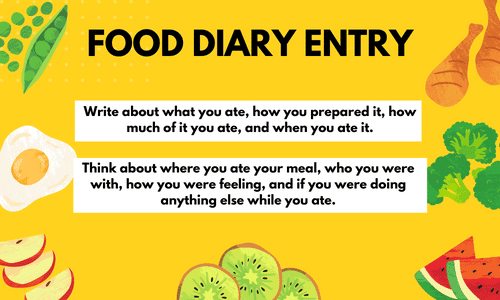

Strategies to Improve Heart Health
If you find yourself flipping through heart health magazines and diet books or browsing the Internet for the best diets for heart-healthy eating, a coronary heart disease dietitian can help by recommending ways to change up your diet.
A cardiac dietitian can also assist clients by developing personalized eating plans. Eating plans are tailored to the lifestyles of clients to be both practical and sustainable.
Heart Healthy Diets
Below, you will find information about different dietary patterns which have been researched to determine whether they may be beneficial for heart health.
Depending on your specific needs, a heart disease dietitian may recommend to you one of the following dietary patterns: a Mediterranean diet, the portfolio diet, the Dietary Approach to Stop Hypertension (DASH), or a vegetarian/vegan diet.
Mediterranean Diet
For generally healthy individuals and those at risk for heart disease, the 2016 Canadian Cardiovascular Society guidelines suggest following a Mediterranean diet to diminish heart disease risk (7).
This guidance is based on a study, called the PREDIMED study, which compared three diets (7):
- a Mediterranean diet to which extra virgin olive oil was added;
- a Mediterranean diet to which mixed nuts were added; and
- a low-fat diet which was used as a benchmark for the comparison.
This study examined whether following any of these diets affected major cardiovascular events in people whose risk for heart disease was high. It was found that there was a 30% decrease in major cardiovascular events in the two groups who followed a Mediterranean diet.
What is The Mediterranean Diet?
In the 2010 edition of the Mediterranean Diet pyramid, fruits, vegetables, whole grains, and olive oil are highlighted as foods to include with every meal (8). The Mediterranean diet also highlights low-fat dairy products, olives, nuts, seeds, herbs, spices, garlic, and onions as foods to consume daily.
White meats, seafood, fish, eggs, and legumes are highlighted as foods for weekly consumption. Lean cuts of red meat and processed meats can also be incorporated; however, it is recommended they be eaten in smaller amounts and less often. Foods high in sugar and fat like candies, pastries, and soft drinks should only be had every now and then and in small portions.
It is worth noting that, outside of its dietary components, the Mediterranean Diet pyramid also includes lifestyle and cultural components:
- Having moderate portions of food
- Allocating time to cook and taking enjoyment from it
- Cooking and eating with others
- Choosing fresh and seasonal ingredients
- Exercising on a routine basis
- Getting enough rest
Portfolio Diet
A dietitian may also suggest the portfolio diet to address the risk for heart disease. The portfolio diet is vegetarian, and it has been shown to diminish the levels of LDL-C or “bad cholesterol” by 8 to 14% in those who have high levels of lipids (i.e., fats) in their blood (7).
Having high levels of bad cholesterol contributes to your risk of plaque build-up in blood vessels and to your risk of associated disease (9).
The portfolio diet is characterized by multiple components.
- Plant sterol esters from foods like enriched margarine
- Nuts like tree nuts and peanuts
- Viscous fiber from foods like oats, oat bran and barley
- Soy protein from foods like soy milk or tofu
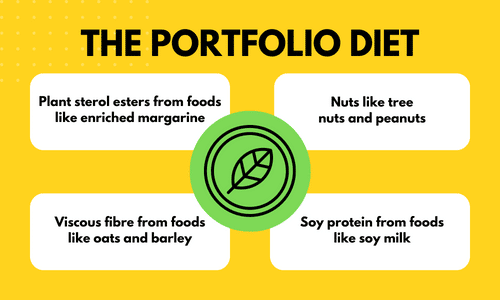
The portfolio diet also recommends having peas, beans, and lentils as part of your diet.
DASH Diet
This diet is based on the DASH study and the DASH-Sodium study which were conducted to assess dietary strategies to lower blood pressure (10)
Although all participants following the DASH diet experienced lower blood pressure, those who had less salt per day experienced the greatest reduction in blood pressure.
The DASH diet can therefore help keep your heart healthy because of its effect on blood pressure as well as its effect on other factors that contribute to heart disease risk.
You can find the different food groups that make up the DASH diet and the recommended number of servings for each food group listed below. (11)
- Vegetables: 4 to 5 servings daily
- Fruits: 4 to 5 servings daily
- Low- or no-fat dairy: 2 to 3 servings daily
- Whole grains: 7 to 8 servings daily
- Fats and oils: 2 to 3 servings daily
- Lean meats, poultry, and fish: ≤2 servings daily
- Nuts, seeds, and dry beans: 4 to 5 servings weekly (10)
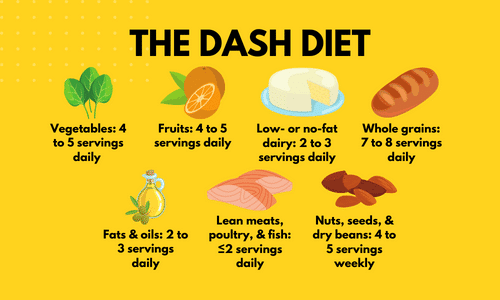
Click on this link to check out a blog article on The Heart Dietitian website for a list of DASH diet smoothie recipes that will help you lower your blood pressure: 19 DASH Diet Smoothies For Blood Pressure – The Heart Dietitian.
Vegetarian/Vegan Diet
Both vegetarian and vegan diets are centered around plant-based eating and cutting out meats.
The main difference between a vegetarian diet and a vegan diet is that a vegetarian diet includes eggs and dairy while a vegan diet does not. On a vegan diet, a person may also opt to avoid gelatin and honey, along with other animal products and animal byproducts.
A vegetarian diet may improve blood pressure, cholesterol, body weight, and the incidence of diabetes, which may also diminish associated heart disease risk.
In comparison to diets that are meat-based, vegetarian diets tend to contribute more fiber, magnesium, potassium, folate, and antioxidants like vitamin C and vitamin E and less cholesterol, total fat, and saturated fat (12).
High intakes of saturated fats can elevate LDL-C – the bad cholesterol which we know can contribute to your risk of plaque build-up in blood vessels (13).
Saturated fats come from foods like beef, poultry with skin, pork, full-fat dairy, beef fat, lard, palm oil, palm kernel oil, and coconut oil.
As a general guide, we want to consume saturated fats in limited amounts by following a dietary pattern that emphasizes the consumption of protein sources like lean meats, skinless poultry, fish, low-fat dairy, beans, legumes, and nuts as well as the use of more healthy fats and oils like olive oil and canola oil..
Focus on Adding Foods
In the past, we often focused on avoiding sodium, fat, and sugar. Now, recent guidelines suggest we focus instead on incorporating healthy foods into our diets to crowd out unhealthy foods.
It’s important to have nutrition recommendations geared more towards overall dietary patterns and types of foods (e.g., fruits, vegetables, whole grains) rather than specific nutrients (e.g., fat, sodium) because we as people eat food and not nutrients.
Putting our efforts into incorporating nutritious foods rather than cutting out all the foods we love can be a more positive approach to adopting and maintaining healthy eating behaviors.
Top 3 Recommendations
Some important takeaways for anyone looking to make dietary changes for better heart health include:
- adding plant foods to your diet;
- adding healthy fats to your diet; and
- starting off with a few small goals.
Each of these recommendations is discussed in more detail below.
Adding Plant Foods
Plant foods include everything from fruits and vegetables to whole grains, nuts, seeds, and pulses (i.e., beans, peas, and lentils).
Diets with more plant foods have multiple perks. Having a mixture of whole grains, vegetables, beans, nuts, and seeds as part of your diet can contribute to lower blood pressure and cholesterol.
Furthermore, plant foods will help you get the fiber you need. In fact, diets with high amounts of viscous fiber can diminish LDL-C (7).
Diets with more plant foods can also be more budget-friendly since plant proteins like lentils, beans, split peas, tofu, peanut butter, and seeds are often cheaper than animal proteins.
It is worth noting that the suggestion to add more plant foods is geared towards having more nutritious, whole foods and less highly processed foods like veggie dogs, mock chicken nuggets, chips, and sweets.
Eating more plant foods doesn’t have to be an all-or-nothing situation. Setting a goal for yourself where you try out a new plant-based recipe or even simply add plant food to a dish that you would normally prepare at home is a great first step.
For example, you could substitute half the quantity of beef in your beef chili or your beef tacos with beans, you could add chickpeas to your salad instead of chicken, or use a fortified soy beverage instead of milk in your oatmeal.
The links below have many recipes that can help you whip up delicious, plant-based meals in the kitchen:
- Vegetarian | American Heart Association
- Recipes – Half Your Plate
- Meatless main dishes | Heart and Stroke Foundation
Adding Foods with Healthy Fats
There are two types of fats that are referred to as “healthy fats”.
Monounsaturated Fats
Monounsaturated fats are healthy fats that are found in canola oil, olive oil, peanut oil, non-hydrogenated margarine, almonds, pistachios, cashews, pecans, and hazelnuts.
Monounsaturated fats in moderate amounts can help lower LDL-C and heart disease risk when they are consumed instead of unhealthy fats.
Polyunsaturated Fats
Polyunsaturated fats are also healthy fats and are comprised of omega-3s and omega-6s.Omega-3s may be beneficial for heart health and are found in mackerel, sardines, herring, rainbow trout, salmon, canola oil, soybean oil, eggs fortified with omega-3, flaxseed, walnuts, pecans, and pine nuts.
Incorporate omega-3s as part of an overall healthy eating pattern by trying.
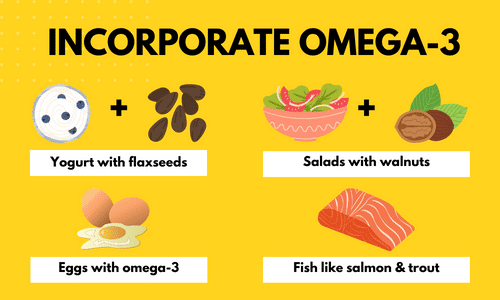
- Omega-6s are found in safflower oil, sunflower oil, corn oil, non-hydrogenated margarine, almonds, pecans, and sunflower seeds.
- Having too much omega 6s may reduce HDL-C or what we call “good cholesterol”. Therefore, omega-6s should be had in moderate amounts. We call HDL-C “good cholesterol” because it takes up the cholesterol in your blood and transports it to your liver, where it will be removed from your system, and because having higher levels of HDL-C can diminish heart disease risk.
All in all, a dietary pattern emphasizing nutritious, whole foods like vegetables, fruits, whole grains, nuts, legumes, fish, poultry, lean meats. As well as reduce highly processed foods like hot dogs, cookies, cakes, and chips to help us to consume less saturated fat and more of the healthy fats.
Starting Slow
Picking 2 to 3 goals to work on is a good place to start when making lifestyle changes. When setting goals for yourself, try to make them S.M.A.R.T – meaning goals that are specific, measurable, attainable, and realistic and that have a time frame.
- Specific: Your goal should be precise.
- For example, instead of having an overarching goal like “having a more heart-healthy diet”, try a more specific goal like “having nuts and seeds as snacks”.
- Measurable: Your goal should also be easy to track.
- For example, a measurable goal could be “having one portion of nuts or seeds at snack time at least twice a week”.
- Attainable: Think about if the goal you set can be achieved.
- For example, if you do not normally eat nuts and seeds, a goal like “having one portion of nuts and seeds at snack time at least 4 to 5 times per week” may not be attainable right away. It may be a goal you need to work up to.
- Realistic: Your goal should work for your lifestyle.
- For example, if you live in a place where access to fresh fruits and vegetables is limited or not cost-effective, incorporating some canned or frozen fruits and vegetables alongside some fresh produce may be more practical.
- Time frame: Finally, your goal should have a deadline.
- For example, “having one portion of nuts and seeds at snack time at least twice a week for an entire month”. Knowing when you can expect to meet your goal helps you determine when to start working on the next goal and ensures you are progressing in the right direction.
Activities To Do With Your Dietitian
Check out this list of activities to do with your cardiac rehab dietitian to ensure you have the tools needed to achieve your health and nutrition-related goals:
- Planning meals
- Discussing cooking strategies
- Finding recipes to try out
- Discussing delicious substitutions for current foods to keep your diet balanced and tasty
- Discussing healthy take-out and fast-food options
- Touring a grocery store
- Reading food labels
- Reviewing your food diary
- Tracking your progress
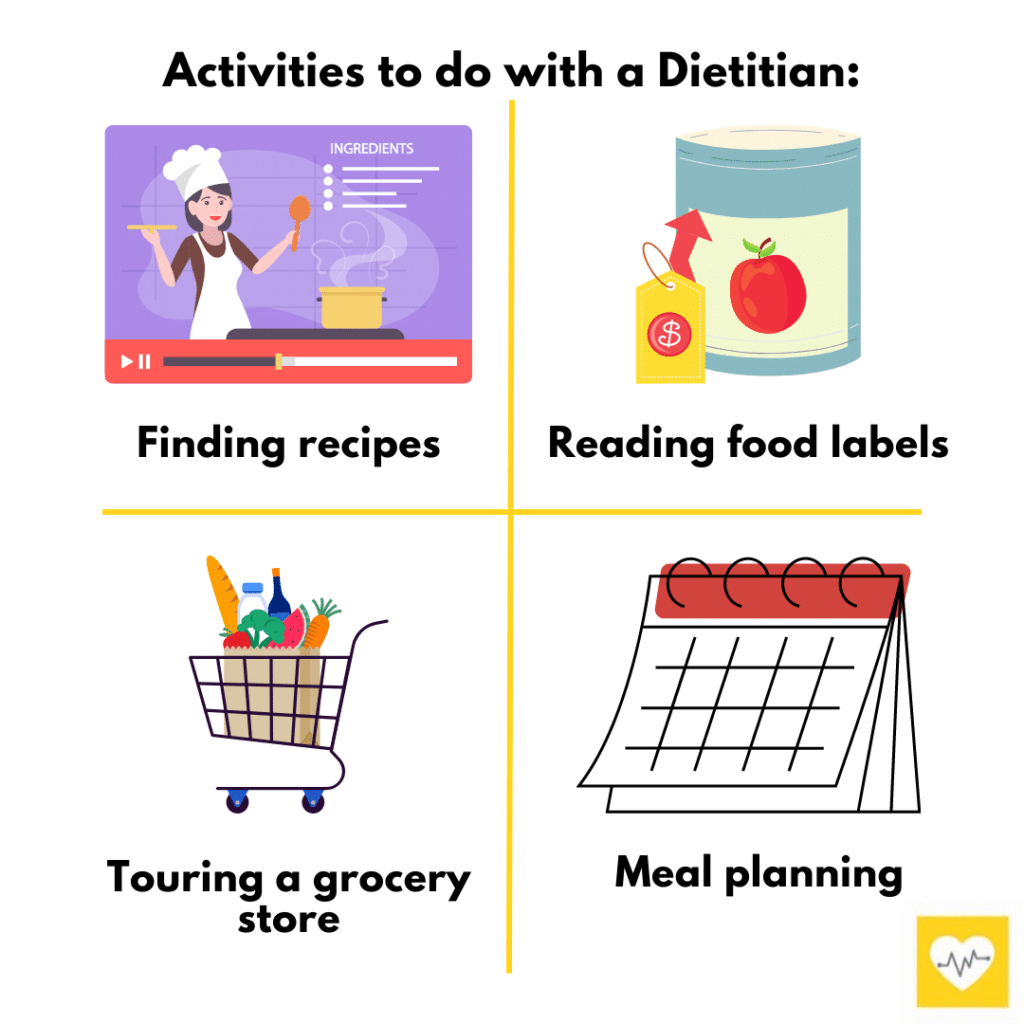
Final Thoughts
Good nutrition not only supports the prevention and management of diseases, like heart disease.
If you have questions about heart disease and nutrition, seek out a heart disease dietitian for clarity and evidenced-based information you can implement with confidence.
If you live in Canada and are interested in working with me, a dietitian for heart disease, please reach out!
Changing habits is not easy and does not happen overnight but working together with a coronary heart dietitian can help you find the solutions that work best for you.
Article was written by Hira Ghani, RD. Reviewed by Veronica Rouse, MAN, RD, CDE.

